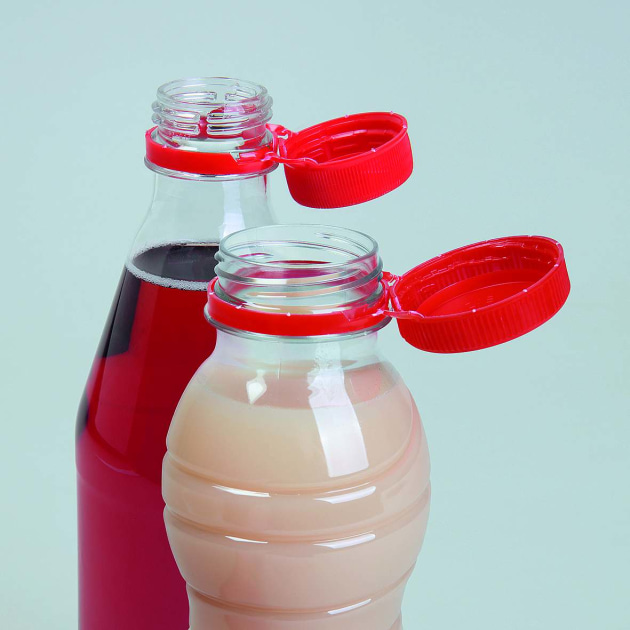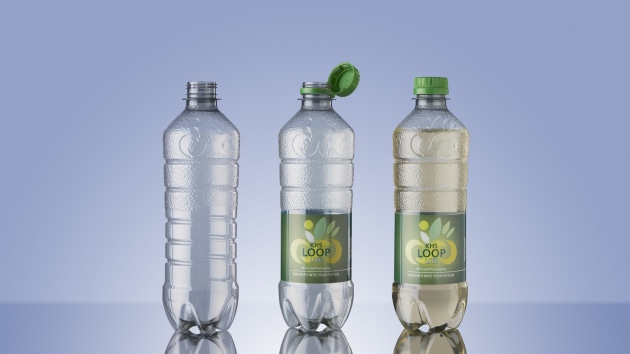In the lead up to mega trade show Interpack, where beverage packaging will be a key focus, the show organiser provides an overview of the choice of packaging formats and considers sustainable options impacting filling and packaging processes.
Some beverages simply come in classic packaging. We usually buy beer or wine in a glass bottle, milk in a carton, and soft drinks in a PET bottle. Over the last few years, however, consumers have become more critical, and sustainability issues have grown in importance for the beverages sector.
Will there be paper bottles?
At the end of 2016, the Carlsberg Group presented the 'Green Fiber Bottle', its prototype for a paper bottle, for the first time. In the summer of 2020, the beverages corporation Diageo announced the first paper-based spirits bottle for Scottish Johnny Walker whisky, but so far there has been no large introduction to the market.
Then, in the beginning of 2021, for the first time in Europe, Coca-Cola offered a plant-based beverage to 2000 consumers in Hungary that came with a paper bottle. No further steps were taken after this test offer, however.
Since the development of sustainable bottles made of fibre, work on their optimisation has never ceased. The goal: a completely organic paper bottle.
Currently, the 'classic' paper bottle still consists of paper coated with a thin layer of polyethylene (PE) which, however, can be easily peeled off during the processing of waste paper, separated and then recycled. One disadvantage of PE is that it doesn’t work very well for carbonated beverages, and these usually require a PET coating that is a bit thicker.
The Carlsberg brewery took things a step further in 2022: The bottles for a large-scale consumer test were coated with PEF (polyethylene furanoate), an organic polymer with similar properties to PET. It acts as a highly effective barrier between the beer and the outer hull made of fibres, protects the taste, and is supposed to retain the carbonic acid of the beer better than conventional PET. The biopolymer is also both compatible with PET recycling systems and biodegradable.
The current prototypes are an already improved variant, which features the PEF coating, as well as a new bottom to improve the stability of the bottle. The next generation of bottles are also planned to be made available with a fibre-based lid and cap.

Lightweight glass
Glass is a popular packaging material for beverages. Its greatest disadvantage is only its high weight, because in direct comparison, PET bottles can be up to 90 per cent lighter than the multiple use variety made of glass. But manufacturers of glass packaging are working on light versions, for example, made of tempered lightweight glass.
Reusable bottles produced this way are not only up to 30 per cent lighter than the standard variety, they are also more resistant to abrasion, which can turn them into a real alternative both economically and ecologically. However, the thermal treatment that in the end gives the glass its greater stability limits the possibilities of product design. Variations in wall thickness present an especially difficult challenge during the process.
Safety in transit

In order for bottles, cans and beverage cartons to reach their point of sale without damage, they need proper safety measures during transportation. Usually, thin stretch wrap is used for stable packing on a pallet. For this purpose, machine manufacturers, like Interpack exhibitor Mosca, offer strapping machines for pallets and stretch winders.
Depending on the type of packaging, safety requirements for the pallet can be very different. Cans must be protected against warping, and glass bottles against breaking. In order to transport lightweight, empty beverage cans, for example, they not only need to be held in place from the side or from the top, but also require light pressure to be kept secure on their way to the beverage bottlers.
A new strapping machine for pallets by Mosca creates the necessary pressure on the empty cans through vertical strapping. The system uses sustainable PET straps made from recycled materials and packages/wraps up to 61 pallets per hour for transport, without wasting resources. As a narrow strip of plastic is enough to secure even the heaviest pallets, the use of material and the carbon footprint are kept to a minimum.
Alternative to plastic shrink wrap
Inside modern stretch winders, a reel of foil circles the pallet horizontally, while the goods – full cans or fragile bottles – remain static. Elastic stretch wrap is used very often, as pre-stretching the foil increases its stretchability up to 300 per cent.
Manufacturers are already working on a more sustainable solution using renewable material. For example, packaging a pallet with elastic, puncture-resistant paper is a packaging solution that can be fully recycled. For wrapping PET bottles, a paper-based solution that can be completely recycled has recently entered the market: a package band made from 100 per cent kraft paper that wraps around bottles, has a high tensile strength and is able to support enough weight to secure the bottles during transport. The second part of this solution is a clamp made of corrugated cardboard that grips the bottle neck. Individual bottles can be easily separated from the package.
Hygiene is a priority
The beverage can still remains popular. While it used to be the case that cans were primarily filled with beers and carbonated drinks, for some time now there has been a trend towards canning more sensitive products like iced teas, plant-based drinks, juices, smoothies or near-water products. This development poses new hygienic challenges to beverage bottlers.
The system manufacturer KHS responded by developing the fill-and-seal block SmartCan together with the Swiss mechanical engineering company Ferrum, which features optimised hygienic measures. The hygienic space inside the filler part of the block consists of raised sheathing plates on one side, and an enclosure on the other side that has a notably smaller product space around the filler carousel: following the so-called donut principle, this creates a ring-shaped enclosure, reduces the volume of the hygienic space by 40 per cent and allows an optimised, targeted jet of sterile air to stream around the sensitive zone.

Filling technology
Hygiene is also important for the new aseptic filling system developed by Sidel for the growing market for sensitive beverages in PET bottles. The integrated stretch-blow-fill-seal solution is a further development of Aseptic Combi Predis technology, intended to help bottling companies serve the growing market for drinks with a long shelf life, such as juice, fruit beverages, soft drinks, isotonic drinks and tea, as well as liquid dairy products.
The demand for these products, says Sidel, is expected to reach a volume of 192 billion units by 2024, which is an increase of 44 per cent compared to 2011.
Sensitive products are said to represent 55 per cent of the market for non-alcoholic beverages, and the predicted growth of this segment (annual growth rate of 2.3 per cent from 2019 to 2025) is higher for PET bottles than for other materials.
Flexible response
Regarding the packaging of their products, bottling companies today face multiple challenges, both economic and ecological. On one hand, they are subject to pressure from growing time constraints and rising costs, and on the other, the beverage industry is under scrutiny from the legislature right now – especially regarding recycling quotas and carbon emissions.
Considering these developments, Interpack exhibitor KHS is offering its customers a large portfolio of adjustable block solutions, especially for filling PET bottles, among them a new, modular platform that can be customised and expanded. First used for filling glass bottles in 2020, the machines now also fulfil customer wishes for adaptability and a guaranteed future when it comes to plastic bottles.
“Nobody can say which trends the industry will follow in five years”, said Manfred Härtel, product manager filling at KHS. “This is the reason we made our platform modular, so it can be fitted any time for different drinks or PET containers, depending on the demands of the market.”
This way, additional individual components can be bought at a later time and integrated into existing solutions with a minimum of effort. In addition, many improvements in construction already help to save energy.
The new filler allows filling temperatures to rise to 24 degrees Celsius, which lowers the investment and maintenance costs for energy-intensive cooling technology. At these temperatures there is also no condensation of water, which would have to be dried using a lot of energy before further packaging in foil or cardboard.

Tethered caps soon to be mandatory
Caps and valves are often a problem when it comes to littering and the recycling of plastic bottles. EU legislation is therefore making the use of closures that are permanently connected to the bottle mandatory from 2024.
Many manufacturers have already reacted and developed so-called tethered caps. Earlier than necessary, manufacturers of beverages are already following the EU guideline, among them Coca-Cola: The corporation already introduced their attached caps in 2021, and has been expanding them to an increasing number of PET single use bottles.
Little has changed for consumers: The opening mechanism is the same, and the cap which is now attached to a safety ring, can still be moved round the neck of the bottle as desired or secured in a specific position. By January 2024, the beverage corporation aims to have successively converted all its German plants. At the end of 2021, the bottling plant in Dorsten, North Rhine-Westphalia, was the first to make the change.
Manufacturers assume that the new caps will only resonate well with consumers if the handling is right. Consumer studies reveal that a tethered cap by Interpack exhibitor Bericap did well because of its intuitive handling, the 180-degree-opening, and its hygienic advantages. An early switch to tethered caps can allow beverage companies to increase the attractiveness of their products in the market.
Intelligent caps
Freshness indicators are helpful for the beverages sector as well. United Caps and the start-up Mimica have marketed a clever cap solution that includes a freshness indicator. The Touchcap changes its surface from even to uneven when a product is no longer fit for consumption. This is possible thanks to a gel in a special label that can change its structure. The cap can be recycled and consists of a lid base and a closing cap.
After filling, this is mounted by a specialised machine that, like other modules – for example for labelling or stretch wrapping – can be seamlessly integrated into production. It is the consumer who activates the effect by opening the lid for the first time by twisting the cap. Currently, there is a pilot project in the UK with an orange juice brand.
This article was first published in the January-February 2023 print issue of PKN Packaging News, p54.
Information on Interpack, including a list of exhibitors, an interactive hall plan, and how to buy tickets can be found at www.interpack.com.
Messe Reps is your contact in Australia for Interpack. Information is available on trade fairs and Dusseldorf on the website messereps.com who can also assist you with travel planning and finding accommodation.






